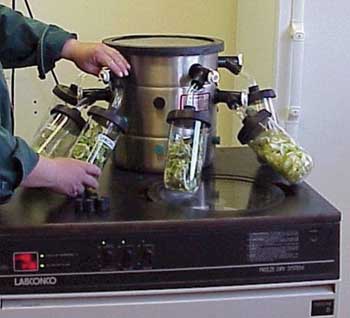Measuring Perchlorate Levels in Lettuce
Preliminary study analyzes factors affecting uptake
2003
Arizona Agricultural Experiment Station Research Report
![]()
Written by
Joanne Littlefield

Lettuce samples are freeze-dried to prepare them for perchlorate analysis.
A leak from a rocket fuel plant into the groundwater near Henderson,
Nevada has led to perchlorate contamination in the lower Colorado River.
As the river moves from Nevada to Mexico the water is redirected for urban,
industrial and agricultural use. Colorado River water is used for both
drinking and irrigation throughout the region.
A concern that perchlorate would make its way into the human food chain
through vegetables such as broccoli, cauliflower and lettuce has been
the stimulus for research by University of Arizona research scientist
Charles Sanchez, director of the College of Agriculture and Life Sciences
Yuma Agricultural Center.
Perchlorate is one of the main ingredients of solid rocket propellant. Improper disposal of perchlorate-containing chemicals may result in contaminated soil and water. Because it can affect humans by inhibiting the thyroid’s uptake of iodine, Sanchez has been evaluating the extent to which perchlorate is found in desert food crops irrigated with Colorado River water. Perchlorate levels in water have been as high as 14 parts per billion, detected at Lake Mead.
“What I measure in water at the Imperial diversion dam near Yuma ranges from 2 to 7 parts per billion,” Sanchez says. The lower concentrations may be due to biological factors, such as uptake by aquatic and riparian plant species along the river, and perhaps microbial reduction. It appears that microbial organisms capable of reducing perchlorate to chloride are fairly widespread; however, conditions that favor this reaction rarely exist in nature.
A preliminary survey conducted in 2002-2003 generally found perchlorate
concentrations near or below detection for most vegetable crop species
sampled, including most vegetables eaten as roots and fruits. The exception
was leafy vegetables such as lettuce, where the foliage is consumed. However,
for iceberg lettuce most of the perchlorate was in the frame and wrapper
leaves, which are discarded, and not the head, which is consumed.
Sanchez hopes to expand this preliminary survey into a more comprehensive,
statistically rigorous, geo-referenced study across a wider range of leafy
vegetables over the next couple of seasons. Initial funding came from
the Arizona Iceberg Lettuce Research Council and a cooperative agreement
with the USDA-ARS (Agricultural Research Service).
Sanchez is continuing his work funded by the Arizona Iceberg Lettuce
Research Council during 2003–2004 by looking at some of the factors
affecting uptake of perchlorate by plants. There is considerable variation
in the perchlorate accumulation within lettuce despite the fact it all
is irrigated with the same water.
“Perhaps fertilization practices, water management practices, or genetic variation are important,” Sanchez says. “We are also concerned with potential sources of perchlorate in addition to irrigation water.” Sanchez notes recent EPA and USGS studies have identified certain fertilizers and agricultural amendments as sources of perchlorate.
Other important research issues Sanchez plans to pursue include evaluation
of the extent to which perchlorate has accumulated in soils and to what
extent it has tainted local groundwater sources. He as recently teamed
up with a toxicologist from the University of California at Riverside
where this data will be used for preliminary exposure and risk assessment
research.
The debate over the suitable standard of perchlorate in water and how
much is safe for human consumption has been turned over to the National
Academy of Sciences, Sanchez says.
“With conclusions possibly by mid-2004, the Food and Drug Administration (FDA) can develop recommendations based on how much salad people consume daily, and what the relative source contribution is from water that’s tainted with perchlorate, and from food that’s tainted with perchlorate.”
CONTACT:
Charles Sanchez
(928) 782-3836
sanchez@ag.arizona.edu
Return to the Title Page
Return to the Table of Contacts
The University of Arizona is an Equal Opportunity/Affirmative
Action Employer. Any products, services, or organizations that are mentioned,
shown, or indirectly implied in this publication do not imply endorsement
by the University of Arizona.
Published January 2004
Return to College publication list